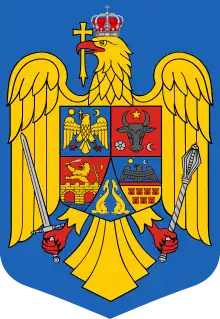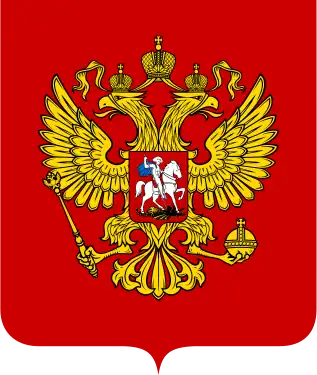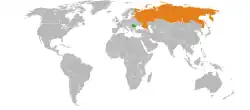 | |
Romania |
Russia |
|---|---|
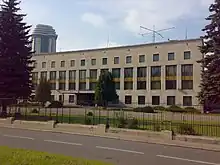
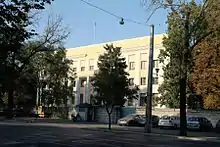
Romania–Russia relations are the foreign relations between Romania and Russia. Romania has an embassy in Moscow and consulates-general in Rostov-on-Don and Saint Petersburg. Russia has an embassy in Bucharest and a consulate-general in Constanţa. Historical relations have oscillated among grudging cooperation, neutrality, open hatred and hostility.
Both countries refused to recognize Kosovo's declaration of independence from Serbia and strongly supported its territorial integrity. About 30,000 Russians live in Romania, mainly in the Tulcea County (see Lipovans). About 5,308 Romanians live in Russia, mainly in the Russian Far East. Both countries were full members of the Council of Europe and the Organization for Security and Co-operation in Europe, until Russia was suspended from the former in 2022.
In 1992 and 1993, relations between the two were especially strained when they backed opposite sides in the Transnistria conflict. Romania is part of NATO, which Russia views in a highly negative light. Debates over the status of Transnistria maintain antagonism between Romanians and Russians. Furthermore, according to The Balkans: Nationalism, War, and the Great Powers, 1804–1999 by Misha Glenny, dislike of Russia and Russians is deeply integrated into Romanian culture since the end of the 19th century due to chronic quarrels between the two countries, and has been for most of the modern era.
Russian opinion on Romania is highly mixed and varied according to the geo-political considerations at one given time, ranging from indifference, sometimes to slight esteem, at times deep frustration and even profound disconsideration. The slight esteem derived from common grounds reached between the two sides at various times, a common Christian Orthodox faith and some common cultural values. Deep frustration and even profound disconsideration remained nevertheless the predominant Russian reaction when both sides were locked into geopolitical struggles.
As one primary Russian geopolitical objective has been expansion of its influence into the Balkan Peninsula the two sides became more often adversaries than partners.
History
18th and early 19th centuries. Russian Protectorate
The relationship between the two countries started during the 15th century, when a Moldavian prince, Stephen the Great, married his daughter to the Tsar's son. In 1712, another Moldavian prince, Dimitrie Cantemir allied with Peter the Great to gain independence from the Ottoman Empire. He became one of Peter's courtiers.
Russian-Romanian relations were generally cordial until the end of the 18th century when Russia was helping Wallachia and Moldavia, two principalities that would later join to create Romania, free themselves of Ottoman domination. Russia's role as a spiritual "guardian" for the Ottoman Empire's Orthodox Christian subjects was affirmed in the 1774 Treaty of Kuchuk Kainardji, and Russia soon after gained a border with the Ottoman Empire right next to the principalities.[1] The "Danubian Principalities" were then semi-autonomous, ruled by Greek Phanariot hospodars, whom the Romanians (both the boyars and the peasantry) widely resented.
Russia's influence waxed in Walachia and Moldavia as Ottoman power waned. In 1739 and 1769, the Russians briefly occupied the principalities. Then in 1774, Catherine the Great agreed to return Moldavia, Walachia, and Bessarabia to the Turks, but she obtained the right to represent Orthodox Christians within the Ottoman Empire and oversee the principalities' internal affairs. In 1787, the Imperial Russian Army again marched into the principalities, but a stalemate gripped forces on all fronts and in 1792 the empress and sultan agreed to reaffirm existing treaties. In 1802, the Porte agreed to halt the rapid turnover of Phanariot princes; henceforth, the princes would reign for seven-year terms and could not be dethroned without Russian approval.[2]
In 1806, forces of Tsar Alexander I reoccupied the principalities, and the local peasants were subjected to forced requisitions, heavy labor obligations, and real threats of exile to Siberia. As a result, the Romanians, who once had looked to the tsar for liberation, developed an abiding mistrust of the Russians that would deepen in the next century. In 1812, Russia and the Porte signed the Peace of Bucharest, which returned the principalities to the Ottomans and secured Russia's southern flank during Napoleon's invasion; Russia, however, annexed Bessarabia and retained its right to interfere in the principalities' affairs. Despite Russia's concessions, the treaty so displeased the sultan that he had his negotiators beheaded.[2]
In 1821, Greek nationalists headquartered in Odessa took control of Moldavia as the first step in a plan to extricate Greece from Ottoman domination. Phanariot rule in Walachia and Moldavia led the Greek nationalists to view the principalities as possible components of a renascent Byzantine Empire. The insurgency's leader, Alexander Ypsilanti, a general in the Russian army and son of a Phanariot prince, enjoyed the support of some Greek and Romanian boyars in the principalities; after more than a century of extortion, however, most Romanians resented the Phanariots and craved the end of Greek control. Tudor Vladimirescu, a peasant-born Romanian whose wits and military skill had elevated him to boyar rank, assumed power in Walachia in an anti-Phanariot national uprising directed at establishing a Romanian government under Ottoman suzerainty. Russia denounced both Ypsilanti and Vladimirescu. The two rebel leaders argued in Bucharest; afterwards, Greek officers shot the Romanian, mutilated his body, and dumped it into a pond, an act that also ended Romanian resistance, which evaporated after Vladimirescu's death. Then the Turks, with Russia's approval, attacked the principalities, scattered the Greek forces, and chased Ypsilanti into Transylvania. The Greek rebellion shocked the Porte, which no longer appointed Phanariot princes to the Walachian and Moldavian thrones and chose instead native Romanians.[2]
Later, in 1826, an internal crisis forced the sultan to accede to Russia's demand for greater influence in the principalities. The Porte gave Russia the right of consultation regarding changes on the two thrones; this concession assured Russia predominant influence at Bucharest and Iași. Russia again invaded the principalities during the Russo-Turkish War of 1828, which resulted in the 1829 Treaty of Adrianople. The treaty provided for Russian occupation of the principalities until the Ottomans had fully paid an indemnity, the election of native Romanian princes for life, and an independent national administration and freedom of worship and commerce under Russian protection. Despite the fact that the Porte remained the principalities' suzerain and could exact a fixed tribute and direct certain aspects of foreign policy, the sultan could neither reject nor remove a prince without Russian consent.[2]
During Russia's occupation, a capable administrator, Count Pavel Kiselyov, improved health conditions, organized a well-disciplined police force, built up grain reserves, and oversaw the drafting and ratification of the principalities' first fundamental laws, the Règlement Organique. Russia used these charters to co-opt Romanian boyars by protecting their privileges, including their tax-exempt status and oligarchic control of the government. However, flawed, the charters gave Romanians their first taste of government by law. The Règlement provided for elected assemblies of boyars to choose each prince, reformed the principalities' judicial systems, and established public education. At the same time, the documents' economic provisions enabled the boyars to stiffen peasant obligations and reduced the peasants' freedom of mobility. After Russia's withdrawal in 1834, Walachia and Moldavia entered a period of self-government during which Russia guaranteed the privileges that the Ottomans had granted.[2]
1848 to 1853
Russia's actions caused a multiplication of anti-Russian sentiment throughout the Principalities, for each group having a different reason. The urban elite (the later Liberals) were frustrated by Russia's opposition to reform in Romania; while landowning boyars (the later Conservatives) were frustrated by Russia's impediments on the economy.[3] Romania was flooded with French literary works transmitting Enlightenment ideas, and due to the similarity of Romanian and French, these had a much faster effect on Romania than other areas.[3] Hence, from a very early time, there was competition between France and Russia for Romania's affinities, even though Russia was the only one of the two to have any real immediate significance to Romania. These feelings provided only strengthened the anti-Russian sentiment in Romania.
During the Revolutions of 1848, Romanians for the first time revolted against Russia, and the Russian flag and the Organic Declarations were burned in public.[3] Romania in fact wooed the Porte, which had to be "persuaded" by Russia not to aid the Romanians.
The uprising of Transylvania's Romanian peasants during the 1848 European revolutions ignited Romanian national movements in Walachia and Moldavia. In Moldavia, Sturdza quashed the revolution overnight by arresting its leaders. In Walachia, however, a majority of the younger generation was averse to Russian and boyar dominance. Revolutionary platforms called for universal suffrage, equal rights, unification of the two principalities, and freedom of speech, association, and assembly. Although he sympathized with the revolutionary movement, Bibescu lacked the courage to lead it. After naming a revolutionary cabinet and signing a new constitution, he fled into Transylvania. The new government of Walachia quickly affirmed its loyalty to the Porte and appealed to Austria, France, and Britain for support, hoping to avert a Russian invasion. The government also formed a committee composed equally of boyars and peasants to discuss land reform. Shocked by the revolution's success in Europe and fearful that it might spread into Russia, the tsar invaded Moldavia and pressured the Porte to crush the rebels in Bucharest. Dissatisfied with Turkey's weak resolve, Russia invaded Walachia and restored the Règlement. After 1849 the two empires suppressed the boyar assemblies in Walachia and Moldavia and limited the tenure of their princes to seven years.[2]
In July 1853, Russia invaded and occupied Romania.[3] Russian occupation was harsh and all political organizations were suppressed. When the Porte declared war on Russia in October of that year, Romanians hoped desperately that Russia would be driven from their country (ironically by the country which they had just recently separated from). This wish was granted by the coalition of both Turkey and Austria against Russia.
Romanian independence
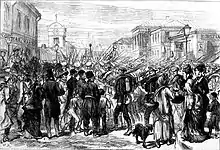
Romania's independence from the Ottoman Empire was achieved mainly with Russian assistance, although during the Russo-Turkish War of 1877 the Russians requested military assistance from Romania during the Siege of Plevna, after suffering heavy losses.[4][5]
1877 to World War I
Fear of Russian encroachment in the Balkans drove the Romanians in 1883 into a secret pact with Vienna. The king, Prime Minister Ioan Bratianu, Foreign Minister D. A. Sturdza, and Romanian Minister to Vienna P. P. Carp supported Romania's orientation toward the Central Powers.[6] In addition there was economic competition with Russia. From very early on, however, Romanian economic competition with Russia throttled good relations. Romania is a natural economic rival of Russia (on the eve of World War II, in fact, it was the world's fourth largest food exporter, after Russia, Canada and the United States).[7] Balkans expert Misha Glenny explains Russia's historical attitude towards Romania as such:
...Russia saw wheat cultivation in Romania as a threat to its own harvests in southern Russia, much of it sold on to Britain and France. If the Principalities were able to modernize the port facilities on the Danube and the Black Sea, they could begin to undercut the price of Russian wheat on world markets. To throttle this competition, Russia exploited its position as protector of the Principalities by allowing the mouth of the Danube to silt up. Russia's interest in the Principalities was essentially strategic. St. Petersburg wanted a pliant satellite, not an economic competitor.
Russia's expansionist designs in the Balkan Peninsula with its conclusive geo-political objective the capture of the strait of Bosphorus and Dardanelles convinced Romania that Russia has no good faith, and forced Romania to look for support somewhere else. Russia's aggressiveness, its projects for territorial conquests was being executed under the policy of Pan-Slavism. Bratianu denounced the danger of the Pan-Slavic idea for the entire Europe.[8] There, on the shores of Bosphorus and Dardanelles, was the key to Europe. Romanian Prime Minister Take Ionescu concludes: "All the efforts made by the empire, all its aspirations, all the Russian impetus are heading towards that point". The Russian conquests in this region would have threatened Romania's existence itself. "We cannot talk about agreements, compromises and concessions. If we still exist, Russia will experience a failure in its plans which have animated the heart of the Russians, for two centuries. If the neighbouring empire succeeds in accomplishing the dream it has pursued with so much confidence and tenacity, the Romanian state and people will become just a memory. This is the truth."[9]
Between 1885 and 1913, Romania and Russia found themselves in two systems of opposed alliances, since both had divergent interests in the Balkan area. Russia's efforts to expand its influence in the Balkans met with the Austro-Hungarian resistance. Since Russia's claims in the Balkans were sustained in most cases by France and Great Britain, and the Austro-Hungarian claims were sustained by Germany, the Balkan Peninsula was about to face the strong political pressures from both side.[10] During the Balkan crisis of 1885–1886 there were marked Russian-Romanian divergences because the Romanian diplomacy supported the election of Ferdinand of Saxe-Coburg at the Bulgarian throne, the candidate backed by Austria-Hungary.
In order to improve relations, St. Nicholas Russian Church(Romanian: Biserica Rusă) was started in central Bucharest in 1905, initiated by Russian Ambassador Mikhail Nikolaevich Giers. The Court of Emperor Nicholas II provided the funds needed for the building (600,000 gold rubles). The structure occupies a surface of 350 m2 and it was set in brick and stone. The seven domes (taking the shape of onion domes — characteristic of Russia, but unusual in Romania) were initially covered in gold. The iconostasis was carved in wood and then covered in gold, following the model of Church of the Twelve Apostles in the Moscow Kremlin. The church was finished in 1909, and it was sanctified on November 25, 1909.[11]

Romania was frustrated with the Triple Alliance and after 1900 moved closer to Russia. Its main goal was to obtain Transylvania, which was part of the Austro-Hungarian empire that was part of the Triple Alliance. that Empire in turn was supported by Germany. Romania therefore was pulled toward the Russian orbit especially during the Balkan Wars of 1912–1913 the Russians appreciated their entry into the Balkans. High-level royal visits were exchanged. In 1914, however, Romania remained neutral at first, finally joining with Russia, France and Britain in 1916.[12]
World War I (1916–1918)
When the war began Romania declared neutrality, but began secret negotiations with Russia and Britain whereby they would recognize Romanian acquisition of Transylvania. Nevertheless, for nearly 2 years Romania remained officially neutral, and traded with Austria and Germany. Sensing the imminent success of the Brusilov campaign in the summer of 1916, Bucharest decided the time was ripe to officially join the Allies. It launched an attack on the Austro-Hungarian Empire in August.[13] Fighting took place from August 1916 to December 1917, across most of present-day Romania, including Transylvania, as well as southern Dobruja, which is currently part of Bulgaria. It ended with the occupation of most of Romania by the Central Powers.
In 1916–1917, the Romanian government signed a deal with the Russian government which stated that Russia would safe keep the Romanian Treasure in the Kremlin until the end of the war. In early 1918, after the Romanian military intervention in Bessarabia, the new Bolshevik government severed all diplomatic relations and confiscated the Romanian treasure. All the governments of Romania since World War I have tried unsuccessfully to negotiate a return of the gold, but all Soviet and Russian governments have refused.
Interbellum
During the interwar period, the Soviet-Romanian relations were marked by the Bessarabian question, as the Soviet Union refused to recognize Romania's acquisition of Bessarabia.[14]
World War II
On 22 June 1941, German armies with Romanian support attacked the Soviet Union. German and Romanian units conquered Bessarabia, Odessa, and Crimea, then marched eastward across the Russian steppes toward Stalingrad. Romania mustered more combat troops for the Nazi war effort than all of Germany's other allies combined. Adolf Hitler rewarded Romania's loyalty by returning Bessarabia and northern Bukovina and by allowing Romania to annex Soviet lands immediately east of the Dniester, including Odessa. Romanian jingoes in Odessa even distributed a geography showing that the Dacians had inhabited most of southern Russia.[15][16]
After the tide of war turned against the Axis Powers, Romania was invaded by advancing Soviet armies in 1944. King Michael of Romania led a coup d'état that deposed the Antonescu regime and put Romania on the side of the Soviet Union for the remainder of the war. Despite this late association with the winning side, Greater Romania was largely dismantled, losing territory to Bulgaria and the Soviet Union.
Romania–Soviet Union relations (1945/47–1990)
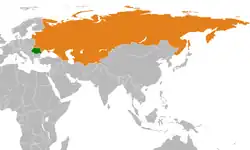 | |
Romania |
Soviet Union |
|---|---|
.jpg.webp)
After coming under communist control in 1948, Romania was closely aligned with the international policies and goals of the Communist Party of the Soviet Union. But after mid-1952, when Gheorghiu-Dej had gained full control of the party and had become head of state, Romania began a slow disengagement from Kremlin domination, being careful not to incur the suspicions or disapproval of Soviet dictator Joseph Stalin. Soviet troops left Romania in 1958, and no Warsaw Pact troops were allowed on Romanian territory after 1962. By that period, the Soviet Union and Romania established SovRoms, which were the new tax-exempt Soviet-Romanian economic corporations that helped the reconstruction of Romania, but also contributed to draining Romania's resources, until they were dismantled in 1956: albeit, some lasted until 1975 with the main focus to assure Soviet access to resources like Uranium.
During the 1968 Warsaw Pact invasion of Czechoslovakia, Romania refused to take part in the operations, and Ceaușescu publicly condemned the actions of the other member states of the pact. The Romanian forces essentially quit participating in joint Warsaw Pact field exercises in the late 1960s. At the same time, Ceaușescu announced that Romania would no longer put the Romanian People's Army under the Warsaw Pact's joint command, even during peacetime maneuvers.
In November 1976, Ceausescu received Leonid Brezhnev in Bucharest—the first official visit by a Soviet leader since 1955.[17] The final communique of the meeting reflected continuing disagreements between the two countries, as Romania refused to side with the Soviets in their dispute with China. In 1978, after visiting China, Ceausescu attended a Warsaw Pact summit meeting in Moscow, where he rejected a Soviet proposal that member countries increase their military expenditures. On his return to Bucharest, Ceausescu explained the refusal by stating that any increase in military expenditure was contrary to the socialist countries' effort to reduce military tensions in Europe.[18]
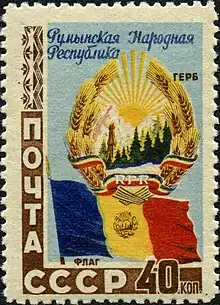
Perhaps because of Ceausescu's uncooperative attitude, a 1980 Romanian attempt to secure supplies of energy and raw materials from the Soviet Union and other Comecon countries failed when those countries demanded world market prices and payment in hard currency. Nor would the Soviet Union guarantee that it would increase or even maintain existing levels of oil exports to Romania for the following year.
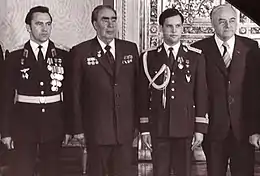
The Soviet invasion of Afghanistan caused Romania to distance itself further from Brezhnev. When the UN General Assembly voted on a resolution calling for the immediate and unconditional withdrawal of Soviet troops, Romania broke with its Warsaw Pact allies and abstained. And one month later, at a meeting of communist states in Sofia, Romania joined the Democratic People's Republic of Korea (North Korea) in refusing to endorse the invasion.[18]
During Yuri Andropov's brief tenure as Soviet leader, relations remained frigid. The wording of the communique following a meeting with Ceausescu in Moscow suggested that Andropov intended to pressure Romania to bring its foreign policy into line with the Warsaw Pact. The Romanian leadership appeared to suspect Andropov of pro-Hungarian sympathies because of his close personal friendship with First Secretary János Kádár of Hungary. Romanian disagreements with the Soviet position on intermediate nuclear forces in Europe also surfaced during the Andropov period.
Romanian relations with the Russian Federation
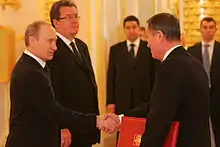
Romania's foreign policy after 1990 was built exclusively on geo-strategic reasons and less on economic relations, which has led to minimal relations with Russia. Relations between Romania and Russia became tense shortly after the fall of Communism due to the Transnistria Conflict which began during the dissolution of the Soviet Union. Following the end of the Ceaușescu regime in Romania in December 1989 and the partial opening of the border between Romania and Moldova on 6 May 1990, the possibility of union between the two states, formerly both part of the Kingdom of Romania, began to be considered, but this also led to protests by Russian inhabitants of the Transnistrian enclave, which instead demanded union with Russia, culminating in a brief but bloody war which pitted the Moldovan government against Russian separatists backed by the Russian government with troops, arms and intelligence. Romania for its part provided military support to Moldova by supplying weaponry, ammunition and armed vehicles,[19][20] and also by sending military advisers and training Moldovan military and police forces.[21] Volunteers from Romania fought on Moldova's side.[22][23][24]
Romania officially declared, in 1993, its desire to join NATO and the European Union to consolidate its precarious national security. In an effort to reassure its former ally, Romania and Russia signed a treaty concerning bilateral military cooperation in 1994 and agreed to continue negotiations on the signing of the bilateral treaty on good-neighborly relations. Despite these efforts, bilateral relations quickly deteriorated. In April 1996, the Romanian-Russian relationship experienced one of its tensest moments, as the Russian Foreign Minister Yevgeny Primakov flew to Bucharest at the invitation of Romanian authorities to sign a renegotiated version of the bilateral good-neighborly relations treaty. Pressed by the opposition parties, President Iliescu changed his mind and Romania refused to sign the treaty, because it failed to address two of the most enduring bilateral disputes between the two countries: Romania decried the treaty's lack of clauses that condemned the Molotov–Ribbentrop Pact (1939) and that would establish a clear roadmap for the return of Romania's National Treasure stored in Moscow. Russia furiously denounced Romanian intentions as hostile and driven by irredentist inclinations towards territories within the Republic of Moldova and Ukraine, to which Moscow considered Romania might lay claim. Also, Russia complained that Romania refused to include a provision that would commit the two parties not to join alliances that are targeted against the other. Following this episode, all bilateral diplomatic visits were canceled. It was only in 1999 that Bucharest said it was ready to reconsider its relations with Moscow, both at political and economic level. By the mid-2000s, a third window of opportunity to normalize relations opened as a result of the 2000 Romanian general elections, which saw the Social-Democrat Party, considered to be closer to Moscow than other Romanian political parties, return to power. Eventually, in 2003, the bilateral treaty on good-neighborly relations was signed, but without addressing any of the contentious issues between the two parties: the condemnation of the Ribbentrop–Molotov Pact, the return of Romania's national treasury, and the provision concerning the parties' commitment not to participate in that are targeted against the other.
A series of high-level contacts culminated with a visit of President Traian Băsescu to Moscow in 2005, but his statements at the time, of overcoming historical prejudice of the previous 15 years, did not take shape as the relations continued to freeze.
A main source of tension continues to be the status of Moldova. The conflict over Moldova, or Bessarabia, is not new. It has been ongoing between Romania and Russia for over a century, due to Russia's strategic interests in the region conflicting with Romania's goal of a unified pan-Romanian state. Bessarabia, now known to most of the world as Moldova, was originally a region within Moldavia, and in 1812 was ceded to Russia after the Treaty of Bucharest. The Southern Bessarabia was regained by Moldavia in 1856 after the Treaty of Paris, but ceded back to Russia after the Treaty of Berlin. Bessarabia was briefly regained by Romania between 1918 and 1940, then retaken by the Soviet Union in 1940, regained by Romania after Operation Barbarossa and lost again to the Soviet Union in 1944 (confirmed by the Paris Peace Treaties in 1947). Romanians may view Moldova as being "stolen" by Russia. At the time of the fall of the Soviet Union, the Romanian language (under the controversial name of the "Moldovan language") with a Latin script was mandated as the official language of Moldova, causing conflict with non Romanian-speaking regions (namely, Gagauzia and Transnistria). However, Moldova opted against rejoining Romania at the time, claiming that it had a separate national identity (see: Moldova–Romania relations; Unification of Moldova and Romania).
On 10 February 2015, Vladimir Evseev, the director of Moscow's Center for Political and Military Studies, has warned that if Romania allows itself to be involved in the confrontation between Russia and NATO, "it is impossible not to put various military bases in Romania on the list of targets to be neutralized with various kinds of weapons." He says that "Russia is terribly worried that cruise missiles may be launched [from military bases about to be built in Romania] as well".[25][26] Romania's president Klaus Iohannis soon approved the temporary deployment of up to 250 U.S. soldiers at a military base in the east of the country. He has also approved a request from the U.S. to use Romania's largest airport in Otopeni as an alternative for transport operations.[27][28]
On 26 April 2021, due to a diplomatic crisis between Russia and the Czech Republic involving spies in the latter's territory, Romania expelled a diplomat at the embassy of Russia at Bucharest, Alexei Grichayev, and declared him a persona non grata in solidarity with the Czech Republic. Other NATO member countries also expressed intention to do similar actions.[29] Time later, a video showing Grichayev allegedly trying to get classified information in Romania regarding its foreign policy, army and energy sector was released.[30]
On 13 March 2022, while the Russian invasion of Ukraine was taking place, an unarmed Russian Orlan-10 reconnaissance drone crashed in the Romanian village of Tărpiu. This followed a similar incident in Zagreb, Croatia, which happened a few days before.[31][32][33]
After the Russian invasion of Ukraine started, Romania, as one of the EU countries, imposed sanctions on Russia, and Russia added all EU countries to its list of "unfriendly nations".[34] Romania joined other countries in spring 2022 in declaring a number of Russian diplomats persona non grata.
Starting in late April 2022, the Russian hacking group Killnet launched a series of cyberattacks against Romanian government and other official websites.[35] This happened after a visit from Romanian authorities to Kyiv where more support for Ukraine was promised while the Russian invasion of the country was still occurring.[36]
Disapproval of the Russian leadership shown in a poll in Romania rose from 37% in 2021 to 79% in 2022.[37]
On 22 June 2023, during the Russian invasion of Ukraine, Ukraine destroyed a bridge at Chonhar connecting Crimea with Russian-occupied parts of southern mainland Ukraine. Following this, Vladimir Saldo, the Russian-appointed governor of occupied Kherson Oblast, threatened that Russia would destroy bridges in Odesa in Ukraine but also a bridge connecting Giurgiulești in Moldova with Galați in Romania.[38] The Prime Minister of Romania Marcel Ciolacu strongly condemned Saldo's threats to both Moldova and Romania. He also hinted that Romania is a member of NATO, described Kherson Oblast as illegally occupied by Russia and stated that striking civilian infrastructure is a war crime.[39] A spokesman for the Ministry of Foreign Affairs and European Integration of Moldova, Igor Zaharov, also condemned Saldo's declarations.[38]
Dispute over the Romanian Treasure
After the fall of the Soviet Union, the Russian governments' position toward the Romanian Treasure remained the same and various negotiations failed. The Romanian-Russian treaty of 2003 did not mention the Treasure; presidents Ion Iliescu and Vladimir Putin decided to create a commission to analyze this problem, but no advances were made.
Dispute over Bessarabia
Regarding the annexation of Bessarabia, the Romanian historian A.D. Xenopol said:
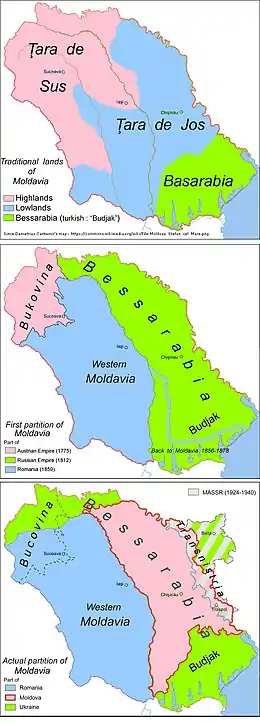
Răpirea Basarabiei ar fi trebuit să înveţe pe români cu lucrul: că dacă există vreun pericol pentru existenţa lor ca naţiune, acesta va veni de la nord; dacă este vreun element adevărat duşman al elementului român, este acel rusesc, care nu din întâmplare, din neîngrijire pune în pericol existenţa noastră, ci lucrează cu conştiinţă la distrugerea ei. Acest pericol l-au simţit toţi românii acei ce şi-au iubit într-adevăr poporul şi care au binemeritat de patria lor. Toată dezvoltarea noastră naţională este datorită luptei neîmpăcate în contra acestui element cotropitor, luptă în mare parte susţinută cu ajutorul apusului. În asemenea împrejurări, a face politică rusească este a da noi înşine arma în mîinile ucigaşului, este a trăda interesele cele mai sfinte ale cauzei române.[40]
The theft of Bessarabia should teach Romanians one fact: if a threat to their existence as a nation existed, this comes from the North; if there was one true enemy of the Romanian element, this is the Russian [threat], that not incidentally or callously endangers our existence, but labors with clear aforethought towards its destruction. This peril has been felt by all Romanians, those who truly loved and sought well to their nation. Our entire national development owes itself to this unreconciled struggle against this onslaught, struggle principally supported with the aid of the West. In such circumstances, to forward Russian politics would be to hand over the weapon ourselves into the hands of the murderer, would be to betray the most holy interests of the Romanian cause.
Friedrich Engels on the annexation:
If for the conquests of Catherine, Russian chauvinism was capable to find some pretexts- I do not wish to say justification but excuse- for the conquests of Alexander there cannot be the talk of anything as such. Finland is Finnish and Swedish, Bessarabia- Romanian, and Poland- Polish. Here there cannot be the talk of uniting related, dispersed nations, that all bear the names of Russians, here we are dealing simply with a conquest by force of foreign territories, simply a theft.[41]
Territorial clashes
Relationships have traditionally been strained by successive geopolitical disputes that saw Romania caught in the crossfire between repeated Russo-Turkish wars, and Russo-Romanian territorial disagreements. Romanian territory has been crossed by Russian armies multiple times throughout history.
Russian entries into Romania:
I. In 1735, a new Russo-Turkish war ignites. Russian armies invade Moldova. The peace is signed in Iasi.[42]
II. 1768, Russia clashes once more with Turkey. Russian armies invade the Romanian Principalities. Catherine II, requests the annexation of the two Principalities, or at least their independence with the intent to annex them later. These requests unease Austria and Prussia, that opposed Russia's expansionist designs in Southern Europe. Treaty of Küçük Kaynarca is signed.[42]
III. . 1787 sees a new Russia-Turkish war. Russia crosses the Dniester river a third time, the eastern border of Moldavia. The Peace Treaty in Iasi (1792) obliges Turkey to cease to Russia the territory between Bug and Dniester, known under the name of Transnistria.
IV. 1806, a new Russo-Turkey confrontation brings the Russians renewed in the Romanian Principalities. Following the weakening of the Ottoman Empire, Austria and Russia oppose each other in their desire to annex these provinces. Such intentions cancelled each other and Russia was forced to withdraw beyond the Dniester.[42]
The impact of these successive occupations of Moldova and Wallachia was devastating. The French Major General Louis Auguste Francois Mariage observes: "the inhabitants were more exposed, aside these requisitionings, let's call them regular, to any sort of abuse, theft, plundering, that brought them into poverty" or "… the Russian army destroyed this country [Wallachia] to such a level, that at the beginning of the year, she offered nothing more than the image of a waste."[43]
V. A new crossing into Romanian territory (the fifth) occurs in 1811, during the Russo-Turkish war. Turkey is defeated, and is requested to cease the territory of Moldavia up to the Siret River. As Napoleon had decided on attacking Russia, these [Russia] hasten to sign a peace treaty with the Ottomans, and accept only the territory between Dniester and Prut (Turkey had guaranteed the territorial integrity of the Romanian Principalities when these accepted to enter a status of vassals in the 1500s, so the annexation lacked any legal means. Russia annexes Bessarabia and begins the process of Russification.[42]
VI. On the eve of the Greek Uprising against Turkey, and the attempt to co-involve the Romanian Principalities, Russian troops again cross the border.
VII. 1828 sees another Russo-Turkish war. Russia occupies Moldova and Dobrogea for 6 years. Pavel Kiselyov was appointed to command the Russian occupying troops in Wallachia and Moldavia, and appointed Plenipotentiary President of the Divans in Wallachia and Moldavia (de facto governor) on October 19, 1829 (he was in Zimnicea at the time). He remained the most powerful man in the Danubian Principalities until 1834. The poverty inflicted on the local population was extreme: "The Russian occupation came with its set of ills: unbearable thefts, incessant requests for carts for transportation, brutality and abuse that befell the people."[43]
VIII. The Romanian Revolutions of 1848 (Wallachian Revolution, Moldavian Revolution) were also suppressed through the intervention of Russian troops, that invade for an eight time Romanian territory. The Convention of Balta Liman, decides the stationing of 35 000 Russian soldiers in the principalities.
IX. 1853. A renewed Russian invasion. The treasury of the Romanian principalities is plundered. 1853 the Crimean War erupts. Its peace treaty decides restituting Southern Bessarabia to Moldova.
X. 1877 renewed Russo-Turkish War (Romanian War of Independence, in Romanian historiography). Despite guaranteeing the integrity of Romania, the conclusion of the war sees the Russian annexation of Southern Bessarabia. Romania receives Dobrogea following the Treaty of Berlin.
XI. 1916. Russian forces accidentally cross into Mamornița, Romanian territory, and a clash occurs there, ending in Russian withdrawal.
Gallery
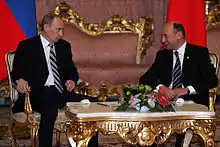 Vladimir Putin and Romanian President Traian Băsescu
Vladimir Putin and Romanian President Traian Băsescu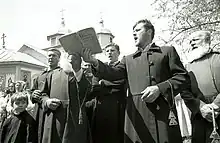 Lipovans (Russian Old Believers) during a ceremony in front of their church in a Romanian village
Lipovans (Russian Old Believers) during a ceremony in front of their church in a Romanian village
See also
References
- ↑ Glenny, Misha. The Balkans: Nationalism, War and the Great Powers; 1804–1999. Page 15
- 1 2 3 4 5 6 "Romania – The Russian Protectorate". countrystudies.us. Retrieved 2015-11-21.
- 1 2 3 4 Glenny, Misha. The Balkans: Nationalism, War and the Great Powers. Pages 57-69
- ↑ "Reminiscences of the King of Roumania", ed. Harper&Brothers 1899, pp. 275 https://archive.org/stream/reminiscencesofk00kremiala#page/274/mode/2up
- ↑ Glenny, Misha. The Balkans. Page 61-2
- ↑ Nicolae Cazan, "The secret treaty of alliance between Romania and Austria-Hungary" Revue Roumaine d'Etudes Internationales (1973) 4#19 pp 185-205.
- ↑ Glenny, Misha. The Balkans: Nationalism, War and the Great Powers. Page 61
- ↑ Brătianu, G. (1877). Le panslavisme et ses dangers pour L'Europe. Paris. p. 53.
{{cite book}}: CS1 maint: location missing publisher (link) - ↑ Ionescu, T. (1891). Politica externă a României. Bucharest. pp. 18–19.
{{cite book}}: CS1 maint: location missing publisher (link) - ↑ Dinu, Elena Steluța (2015). "Balancing Romania-Russia Relations: A Grounding of the Balkan Crisis Through Proper Application of Political Conditionalities" (PDF). Revista de Stiinte Politice (45): 76–88.
- ↑ Olteanu, Radu (2002). Bucureștii în date şi întâmplări ("Bucharest in facts and events"). Bucharest: Editura Paideia.
- ↑ Sorin Arhire, "From Hostility to Friendship: the Russian-Romanian Relations in the Years Prior to the Outbreak of the First World War." ‘’Былые годы. Российский исторический журнал’’ 3.53 (2019): 1383–1393.
- ↑ Vladen N. Vinogradov, "Romania in the First World War: The Years of Neutrality, 1914–1916." International History Review 14.3 (1992): 452-461.
- ↑ Steiner, Zara (2005). The lights that failed : European international history, 1919-1933. Oxford: Oxford University Press. ISBN 978-0-19-151881-2. OCLC 86068902.
- ↑ U.S. government Country study: Romania, c. 1990.
 This article incorporates text from this source, which is in the public domain.
This article incorporates text from this source, which is in the public domain. - ↑ Bachman, Ronald D.; Keefe, Eugene K. Area handbook for Romania; Library of Congress. Federal Research Division (1991). Romania : a country study. The Library of Congress. Washington, D.C. : The Division : For sale by the Supt. of Docs., U.S. G.P.O. pp. 41.
 This article incorporates text from this source, which is in the public domain.
This article incorporates text from this source, which is in the public domain. - ↑ "Заявление о дальнейшем развитии сотрудничества и братской дружбы между КПСС и РКП, Советским Союзом и Румынией | Проект "Исторические Материалы"".
- 1 2 Country data- Romania
- ↑ Arms and Ethnic Conflict, John Sislin, Frederic S. Pearson (Rowman & Littlefield, 2001), p. 99, ISBN 0-8476-8855-0
- ↑ Managing Conflict in the Former Soviet Union: Russian and American Perspectives, Alexei Arbatov, et al. eds. (Cambridge: MIT Press, 1997), p. 178, ISBN 0-262-51093-6
- ↑ (in Russian) "Вождь в чужой стае" by Mikhail Bergman
- ↑ Richard Humphries. Transnistria: relic of a bygone era, The Japan Times, 8 October 2001. Retrieved 6 August 2014
- ↑ "Ethnicity and power in the contemporary world" Chapter 5, "Dynamics of the Moldova Trans-Dniester ethnic conflict (late 1980s to early 1990s)", Kumar Rupesinghe and Valery A. Tishkov, United Nations University Press, 1996
- ↑ Приднестровский парламентарий: Причиной приднестровского конфликта стало то, что Молдавия провозгласила себя моноэтническим государством, REGNUM News Agency, 20:04 3 March 2008
- ↑ "Russia warns Romania". Nine O' Clock, World Section. 12 February 2015. Retrieved 14 February 2015.
- ↑ Popescu, Andrei Luca (10 February 2015). "Avertismentul Rusiei pentru România, după anunţul NATO: "Vom căuta mijloace de a anihila flota militară românească"". Gândul, International section (in Romanian). Romania. Retrieved 14 February 2015.
- ↑ "The U.S. brings 250 soldiers in Romanian base as Russia warns it might neutralise the county's military targets". Romania Insider, Daily News. 11 February 2015. Retrieved 14 February 2015.
- ↑ Novaceanu, Alina (3 February 2015). "SUA cer României permisiunea de dislocare la Baza Kogălniceanu a maxim 250 de militari, în 2015". Mediafax (in Romanian). Retrieved 14 February 2015.
- ↑ Berry, Alex (26 April 2021). "Romania kicks out Russian embassy official". Deutsche Welle.
- ↑ Necșuțu, Mădălin (30 April 2021). "Romania releases compromising video of Russian expelled for spying". Balkan Insight.
- ↑ "O dronă s-a prăbușit în apropiere de locuința unui bărbat din Bistrița. Parchet: "Nu a fost stabilită proveniența aeronavei"". Libertatea.ro. 14 March 2022. Retrieved 2022-03-14.
- ↑ "Russian-made Orlan-10 drone crashes in Romania". aerotime.aero. 14 March 2022. Retrieved 2022-03-14.
- ↑ "An unmanned aerial vehicle, most likely of Russian origin, was found in the Romanian municipality of Dumitra, just over 100 kilometers south of the Ukrainian border". Ukrinform. 14 March 2022. Retrieved 2022-03-14.
- ↑ Lee, Michael (8 March 2020). "Here are the nations on Russia's 'unfriendly countries' list". CTV News.
- ↑ "Val de atacuri cibernetice în România. Vizate mai multe instituții, între care Guvernul și Ministerul Apărării / Atacurile, revendicate de hackerii pro-ruși de la Killnet". economie.hotnews.ro (in Romanian). Retrieved 2022-04-29.
- ↑ "Imagini cu Marcel Ciolacu și Nicolae Ciucă la Kiev, cu Volodimir Zelenski. Vizita ar fi trebuit să aibă loc mâine, împreună cu Florin Cîțu". www.antena3.ro (in Romanian). Retrieved 2022-04-29.
- ↑ "Russia Suffers Global Rebuke After Invasion". 25 April 2023.
- 1 2 Gaidău, Ion (22 June 2023). "Reacția Republicii Moldova după ce un oficial rus a amenințat cu un atac asupra podului de la Giurgiulești". Adevărul (in Romanian).
- ↑ "Ciolacu: România condamnă ferm declarațiile așa-zisului "reprezentant" al Rusiei în Herson". Jurnalul Național (in Romanian). 22 June 2023.
- ↑ Xenopol, Alexandru D (1880). Războaiele dintre ruşi şi turci şi înrâurirea lor asupra ţărilor române, vol. I. Iaşi. pp. 217–218.
{{cite book}}: CS1 maint: location missing publisher (link) - ↑ Muşat, Ardeleanu, Mircea, Ion (1983). De la statul geto-dac la statul român unitar. București. p. 199.
{{cite book}}: CS1 maint: location missing publisher (link) CS1 maint: multiple names: authors list (link) - 1 2 3 4 Arnautu, Nicolae I (1996). 12 invazii rusesti in Romania. Saeculum I.O. ISBN 973-9211-39-9.
- 1 2 Xenopol, A.D. (1896). Histoire de Roumains. Paris.
{{cite book}}: CS1 maint: location missing publisher (link)
Further reading
- Arhire, Sorin. "From Hostility to Friendship: the Russian-Romanian Relations in the Years Prior to the Outbreak of the First World War." Былые годы. Российский исторический журнал 3.53 (2019): 1383–1393 [in English].
- Burks, Richard V. "Romania and the Balkan Crisis of 1875-78." Journal of Central European Affairs 2 (1942): 129+.
- Clark, Charles Upson. Bessarabia: Russia and Roumania on the Black Sea (NY: Dodd, Mead, 1927).
- Dinu, Elena Steluta. "Balancing Romania-Russia relations: a grounding of the Balkan crisis through proper application of political conditionalities." Revista de Științe Politice. Revue des Sciences Politiques 45 (2015): 76–88; covers 1885–1913 online.
- Hazard, Elizabeth W. Cold War Crucible: United States Foreign Policy and the Conflict in Romania, 1943–1952 (1996)
- Hitchins, Keith Rumania, 1866–1947 (1994); 592pp
